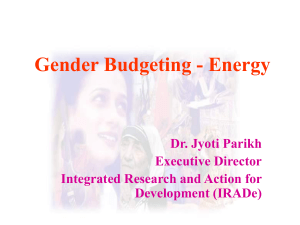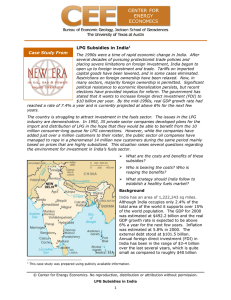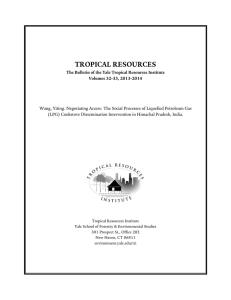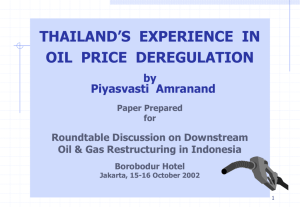Urban and peri urban energy access (UPEA)
advertisement
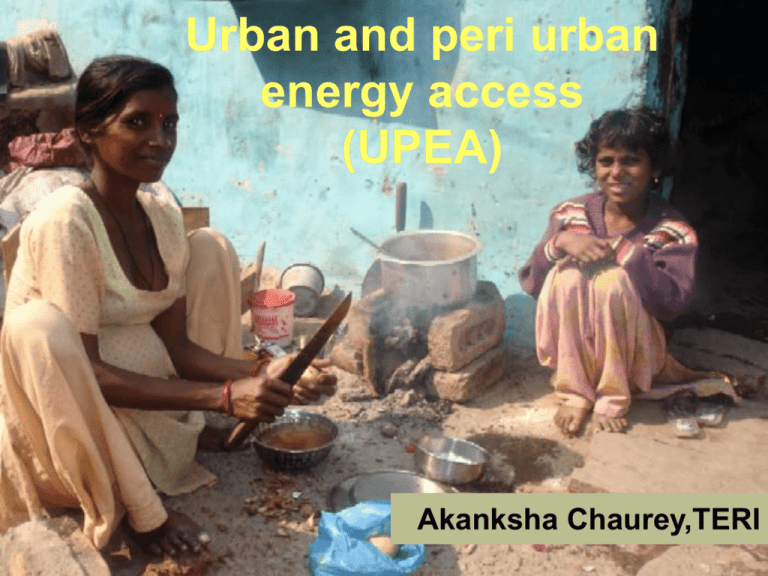
Urban and peri urban energy access (UPEA) Akanksha Chaurey,TERI Introduction Ensuring universal access to clean & modern energy sources Imperative to achieve MDGs 2.4 billion rely on biomass; 1.6 billion have no access to electricity Energy planning and needs assessment for poor- not been adequate Study initiated by GNESD in 2006 Why urban poor? Urbanization and rising urban poverty; a key challenge Large shares of developing countries population reside in slums India (15%) Greater Buenos Aires (13%) Kenya (34%) Migration pressure Lack of adequate infrastructure Inequitable distribution of services in urban services Appallingly unhygienic conditions of slums Glaring energy gap; Urban poor suffer the most Objective To identify challenges and policy options in order to facilitate improved, clean and sustainable energy services to the poor residing in urban areas in developing countries from the perspective of poverty alleviation, environmental protection and productive use of energy. Reporting Centres Centre Coverage AFREPEN Kenya CENBIO, COOPETEC Brazil ERC Cape Town Foundation Bariloche Gran Buenos Aires AIT Greater Bangkok ENDA Senegal TERI Delhi Common Research Hypothesis Is clean energy available? Is it accessible? Is it affordable? Is it reliable and safe to use on a regular basis? Is it being used? Key findings and recommendations Generic observations Mix of modern and traditional fuels used for all applications in all regions (Electricity, LPG, kerosene, biomass, charcoal) Kerosene - base fuel Fuel substitution is common Policy response to clean energy access has been poor and not focussed 1. Lack of strategic planning Lack of clear definition and mapping of poverty in urban and peri-urban areas is depriving people of basic rights; Senegal has more than 5 definitions of urban and peri-urban areas In SA, illegal settlements do not appear on city maps In Brazil, national statistics only distinguish between urban and rural populations Buneous Aires- Layout of dwellings not conducive to electrification Current targets for improving quality of life do not include access to modern energy among basic services. India- Ministry of Urban Development has not included energy in its mega program for slum improvement and basic service delivery to urban poor Policy option/instrument • Identify, map and measure informal settlements as a matter of priority. • Develop comprehensive energy policies and ensure that energy forms part of all actions to improve access to basic services. • Integrate energy services in infrastructure development • Make energy an integral aspect when planning strategies to attain MDGs. • Improve database on consumption, access, perception, etc.trends 2. Inaccessibility due to nature of settlement Lack of a legal address is a major barrier to access, even if people have capacity to pay SA- informal settlements not mapped, get neglected in electrification programs. Not eligible for subsidies India- numerous slum colonies hook electricity illegally and have to buy fuels from black market or forego usage due to lack of valid ID, as they live on unrecognized lands End up paying more for illegal connections SA- extension cords Policy option/instruments/initiatives taken • De-link access to basic services with security of land tenure • Issuance of temporary I-cards like ‘quasi ID’ for people without an official household registration in Thailand • Introduction of new electricity tariffs in Thailand reduced illegal connections • Reduced Tariff for households with monthly electricity consumption up to 150 kWh for a period of three months Introduction of the Electricity Basic Services Support Tariff (EBSST) in 2003 in SA to assist poor households with a record of using less than 150kWh monthly who qualify for a free allocation of 50kWh of electricity per month. 3. High upfront costs High cost of connections for electricity and LPG plus the cost of appliances is a major hindrance to access; India, Kenya Inability to pay electricity bills or purchase refill charges of LPG is a barrier. Irregular incomes; resort to biomass, etc. which can be purchased in smaller quantities at a time- India, Senegal Unregulated LPG prices- Argentina; Declining subsidy -Senegal Policy option/instruments/initiatives taken • Design and introduce ‘consumer-friendly’ ways of spreading connection costs (instalments, etc.). Eg. Greater Buneous Aires-regularization of illegal connections, introduction of common pre-paid meters • Consider extending subsidies to appliances. • Introduce well designed subsidised tariffs for electricity • For LPG ensure that subsidies cover the sizes of cylinders best suited to the poor. Eg. Subsidies on small cylinders-Senegal, “Shesha”-small cylinders in SA • Make sure that subsidies reach the target group and avoid ‘leakage’ to wealthier groups. Eg. Senegal’s specially sited LPG outlets for poor 4. Lack of formal monitoring mechanisms Lack of monitoring through to delivery of energy services can leave the way open for malpractice India- corrupt practices of FPS dealers, harassing of consumers Kenya-sale of half filled cylinders by dealers Senegal-Shortage in supply due to the weakness in the warehousing infrastructure Market structures and movements can adversely affect the poor who are vulnerable to such forces. India- poor forced to resort to black markets for kerosene Kenya- high unit prices for charcoal purchased in smaller quantities Thailand- subsidies only for large LPG cylinders;unaffordable No state level agency responsible; no universal service obligation for provision of clean fuel- almost all countries Policy option/instruments/initiatives taken • Establish agencies with the appropriate responsibilities and powers. • Ensure that there is a full audit trail on subsidised fuels to avoid their diversion to an informal market. • Consider actions to help regulate prices if these are forced up to levels which make energy services unaffordable to the poor. 5. Lack of awareness User attitudes can prevent uptake of modern energy. Taste preferences People expressed doubts about safety aspects of LPG or have inaccurate information about availability. India- One room homes, construction material of slums, sitting on floor cooking, presence of children, perceived to add risk However not aware of ill effects of inefficient burning of biomass Use of old and inefficient appliances Policy option/instruments/initiatives taken • Suppliers to initiate more rigorous outreach activities and raise awareness on usage of clean fuels, esp. targeted to the poor. Eg. South Africa's proposed ‘one-stop shop’ information centres • Development of Free Basic Alternative Energy Policy (FBAE) for promotion of alternative fuels/technologies in SA. However, this is challenged due to capacity constraints at municipal level and peoples resistance to switching to alternative fuels; also better targeting/identification of poor Conclusion Providing clean energy access to urban poor is not merely a technical issue Need to address the administrative and institutional barriers Greater focus on the urban poor in urban development plans and policies Greater focus on clean energy as a basic urban service Each region to design its set of policy instruments and service delivery models to facilitate this Need for involvement of local level bodies, NGOs, etc. Thank you




